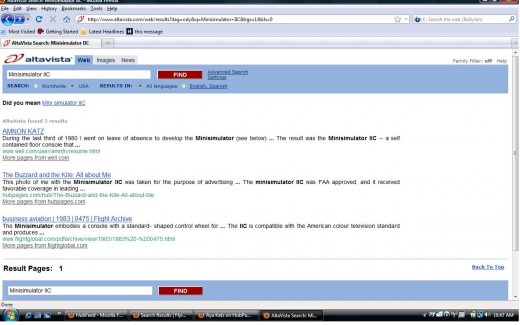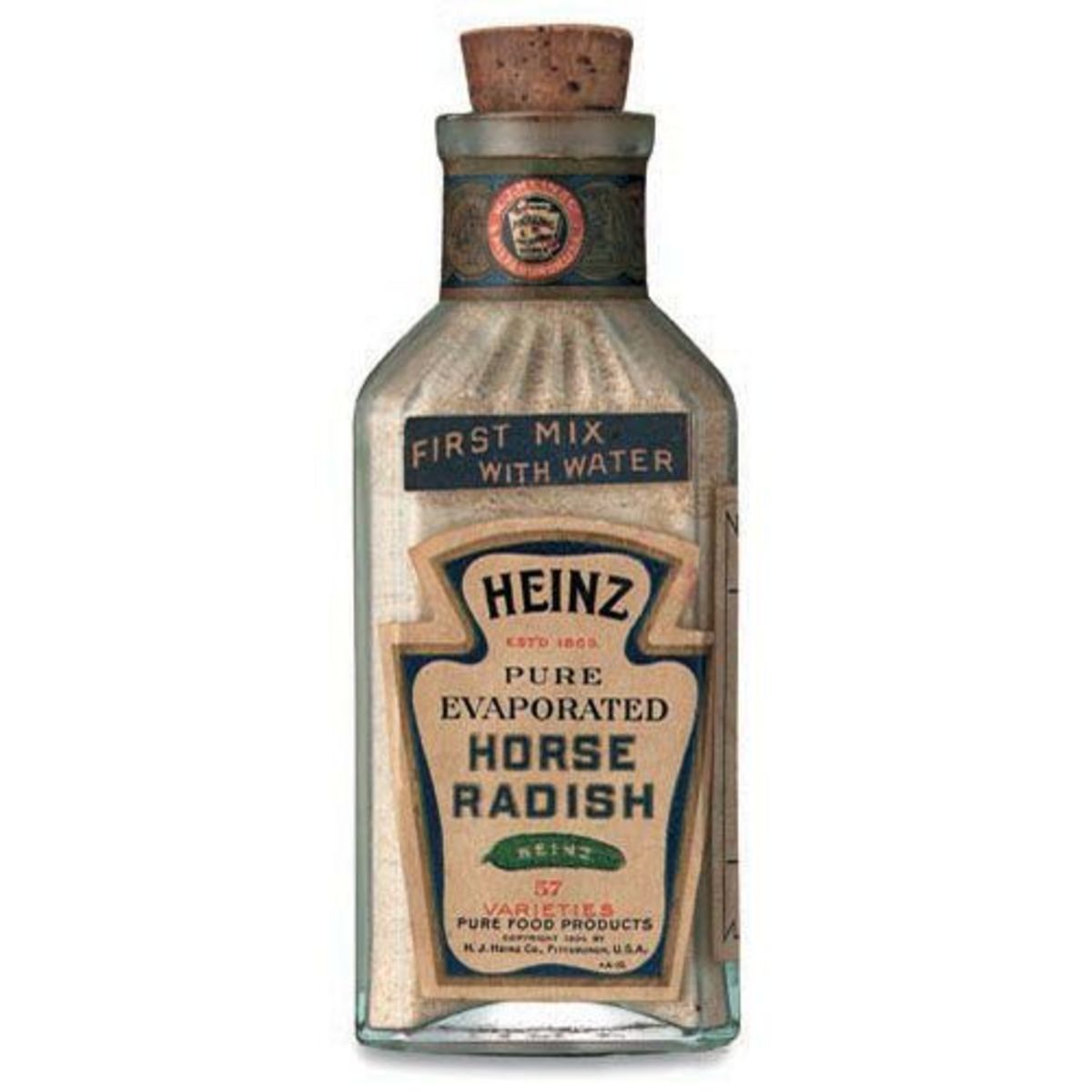How Advertising Shapes Content on the Web and Off
Altavista is my favorite search engine. It always was, and it still is! Why? Because no matter how obscure the topic is, Altavista comes up with relevant information. Take for instance the Minisimulator IIC, a product once manufactured by my father's company, Inverted-A. I looked for it on Google and only found my autobiographical hubs and my father's CV. But I was looking for old press clippings, and only on Altavista could I find them!
Why didn't Google, the world's best search engine, not turn up those clippings? Probably, because it didn't stand to make any money off of them, so it didn't bother to index them. Whereas my autobiographical hubs are modest money makers.
Altavista doesn't care so much about advertising, which is why it is not on top of the market.
Advertising, it turns out, is a very important factor in getting the news out, not necessarily in the sense that advertising will help sell a product, but in the other more hidden sense that unless you work with advertising, it will work against you, to deny and obscure editorial coverage. Take for instance, what happened to the Minisimulator IIC when my father refused to advertise in Flying Magazine.
Search for "Minisimulator IIC"

The Development of the Minisimulator IIC
The Minisimulator IIC was a testament to personal ingenuity and an innovative vision. My father describes its development and history briefly in his CV:
Inverted-A was founded in 1976 as a flying club. It soon turned into a flight school that I ran on the side. More than twenty students were trained for the private pilot and higher ratings in the years 1976-1980. This activity pointed the need for a low-cost digital simulator for instrument training. Work on developing this simulator started in 1979 and continued as a sideline through 1980. After the concept was defined, a leave of absence was obtained for the last four months of 1980 to complete the development and present it to the FAA (Federal Aviation Administration). The result was the Minisimulator IIC -- a self contained floor console that drives a CRT display of the instrument panel and of the ground track.
The IIC was the first CRT based flight simulator, and for a few years the only one, to be accepted by the FAA for credit against requirements for pilot currency and training. The Minisimulator was introduced to the market in 1981. In 1983, with sales picking up, I resigned from LTV to devote my full time to Inverted-A. By now there were Minisimulators in operation coast to coast as well as in Europe, Asia, Australia, and South America. The Minisimulator was further improved, and by 1986 the total number of systems deployed was 51.
Inverted-A didn't have any employees. We subcontracted some of the labor, but we didn't pay by the hour, we paid by the part, and we ourselves did not take a salary. In our corporation, we had no laborers. My father designed the printed circuit board and sent it off to be manufactured to our specifications by a subcontractor. My mother and father designed the cloth portions of the console, and they were subcontracted to seamstresses, many of whom worked at home while watching over their small children. Every part, whether metal, wood or cloth, electronic or mechanical, was either made to order by subcontractors or bought off the shelf. I did quality control and some of the soddering on the PC boards, because I was younger and my close range vision was still sharp. My father and I put parts together in the garage, and all of us had to help with lifting crates.
On top of all that, I was in-house counsel, and I drafted our distributorship contracts. Oh, yes, and I also had to answer the phones and provide relevant information for sales prospects.
My father's dream was not just to make a top of the line flight simulator. It was also to show that it could be done without the suits -- the business people that dominate most corporations without having any technical know how, whose sole job was to get money out of other people.
We also hoped to show that we could do it without employees, people who sell their time, and not their products. My father saw how employees behaved at LTV. Many of them intentionally worked slowly. They had no incentive to finish early, because what they were selling was their time. They didn't want to learn newer, better ways of doing things. They spent much of their time socializing with one another and disturbed other employees who were trying to work.
My father wanted to find a better way.
Minisimulator IIC clippings
- http://www.flightglobal.com/pdfarchive/view/1983/1983%20-%200475.html
- Search Results | Flying Magazine | The Worlds Most Widely Read Aviation Magazine
Find great flying videos from your favorite brands, events, latest aircraft and much more at FlyingMag.com.
Flying Magazine and Reciprocity
The leading aviation journal at the time, and now as well, was Flying Magazine. Initially, they treated us very well. They sent a reporter to cover the Minisimulator IIC, and he wrote a very complimentary article, praising the product. Other aviation journals did the same, and consequently, we had a lot of interest from pilots and a steady stream of orders.
Then Flying started calling us up and pestering us to advertise with them. They suggested that it would help our sales. My father was reluctant. He didn't like advertising. He never read advertisements himself, always muted the commercials on TV, and thought of admen as disgusting parasites who produced nothing, but lived on the products of others.
Nevertheless, at first we did purchase a modest ad. Flying included an insert postcard in the magazine that listed all advertisers and gave the reader a chance to fill in a circle by the name of each product so that they could receive more information. We started getting a list of addresses that were supposed to be sales leads. We sent them our brochure. None of them ordered anything. It was very labor intensive for us at home, my mother, my father and I, to stuff envelopes and mail out information to people who weren't really interested. Only those readers of Flying who bothered to call or write to us in response to editorial coverage ever bought a simulator.
So we stopped advertising."Why should I pay for ads, when I can get articles for free?" my father reasoned.
The sales calls from the Flying advertising department became ever more insistent, but eventually they stopped. Then one day the annual Flying Buyer's Guide came out. And we weren't in it!
The Flying Buyer's Guide was a comprehensive list of all aviation related products available on the market. When it gave a list of flight simulators and failed to include the Minisimulator IIC, it was like announcing to the world that we did not exist.
My father was shocked and angered. It seemed to him that Flying had tried to extort advertising out of us, even though the ads were useless for the purpose of generating sales, and now that we had refused to advertise, they were retaliating by banning us from editorial coverage that was rightfully ours.
We filed a lawsuit for business defamation in the Federal Court in Dallas. Then Flying got a change of venue to New York. I was only licensed to practice law in Texas. My father was not going to hire outside counsel, because that would cost a lot of money. The whole point of everything he did was to live frugally.So we had to drop the suit.
Eventually, our sales came to a grinding halt. And that was the end of this particular experiment in unconventional business practices.
Lessons from the Past
Editorial coverage in a magazine like Flying is something that manufacturers purchase by paying for ads. Ads don't sell products. Articles do. But you can't buy articles directly, hence the subterfuge of advertising.
My father naively believed that Flying had the journalist's ethical mandate to report the news accurately, and that Flying's main duty was to their subscribers, not their advertisers. But the name of the game was selling, and it wasn't subscriptions that paid for that glossy magazine or the salaries of the reporters!
If someone did not advertise, then they might as well not exist, because they were not going to get indexed.
Google and the Competition
If you want to sell a product, you have to pay for PR. An article is always more effective than a mere advertisement, but if you paid for an article directly, it wouldn't be an article. It would just be an ad, and nobody would take it seriously.
Do Google ads sell products? Yes, I think they must, but possibly not in the way we originally thought. I think the web is just like Flying Magazine. People read and write articles about products that are advertised. If there is no advertising on your webpage, people are less likely to read it, because it is less likely to be indexed. If you write with the ads in mind, your article will be read, and there will also be a monetary reward.
One hand washes the other. There's reciprocity for you! And that's why Google is the best search engine in the world -- for advertisers!
But if you're looking for something obscure, like old news clippings about the Minisimulator IIC, then Altavista is the place to go.
(c) 2010 Aya Katz
Related Hubs and Links
- JETS & BOATS FOR SALE
- Search Engine Optimization and its Benefits
If like me you hunger for outstanding online internet marketing success, then search engine optimization is something that you just cannot do without. Why else would all the heavyweights in the industry be in...








